Use of Thermally Assisted Hydrolysis and Methylation (THM-GC-MS) to Unravel Influence of Pottery Production and Post-Depositional Processes on the Molecular Composition of Organic Matter in Sherds from a Complex Coastal Settlement
Abstract
:1. Introduction
2. Materials and Methods
2.1. The Site
2.2. Sample Selection and Preparation
2.3. Color and Elemental Analyses
2.4. THM-GC-MS
2.5. Data Evaluation
3. Results and Discussion
3.1. Color and Elemental Analysis
3.2. Thermally Assisted Hydrolysis and Methylation (THM-GC-MS)
3.3. Comparing THM Data with Color and Elemental Composition
4. Conclusions
Supplementary Materials
Author Contributions
Funding
Data Availability Statement
Acknowledgments
Conflicts of Interest
Appendix A
| RT (min) | Compound | m/z | Group |
| 6.270 | C7 FAME | 74 | FAME |
| 7.406 | C8 FAME | 74 | FAME |
| 8.340 | C9 FAME | 74 | FAME |
| 9.149 | C10 FAME | 74 | FAME |
| 9.865 | C11 FAME | 74 | FAME |
| 10.519 | C12 FAME | 74 | FAME |
| 11.132 | C13 FAME | 74 | FAME |
| 11.702 | C14 FAME | 74 | FAME |
| 12.050 | iso-C15 FAME | 74 | FAME |
| 12.097 | anteiso-C15 FAME | 74 | FAME |
| 12.247 | C15 FAME | 74 | FAME |
| 12.771 | C16 FAME | 74 | FAME |
| 13.259 | C17 FAME | 74 | FAME |
| 13.731 | C18 FAME | 74 | FAME |
| 14.224 | C19 FAME | 74 | FAME |
| 14.618 | C20 FAME | 74 | FAME |
| 15.428 | C22 FAME | 74 | FAME |
| 12.662 | C16:1 FAME | 55 | FAME |
| 13.632 | C18:1 FAME | 55 | FAME |
| 12.662 | C18:2 FAME | 67 | FAME |
| 13.632 | C18:2 FAME | 67 | FAME |
| 8.932 | unidentified alkane | 57 | MCC |
| 9.679 | unidentified alkane | 57 | MCC |
| 10.343 | unidentified alkane | 57 | MCC |
| 10.675 | unidentified alkane (non homologous) | 57 | MCC |
| 10.960 | unidentified alkane | 57 | MCC |
| 11.334 | unidentified alkane | 57 | MCC |
| 11.796 | unidentified alkane | 57 | MCC |
| 14.359 | N,N-dimethylalkylamide | 87 | NCOMP |
| 12.553 | unidentified MCC (alkene/ether) | 83 | MCC |
| 13.311 | unidentified MCC (alkene/ether) | 83 | MCC |
| 6.477 | C4 DAME | 59 | DAME |
| 8.548 | C6 DAME | 59 | DAME |
| 10.696 | C9 DAME | 59 | DAME |
| 5.912 | benzonitrile | 103 | PyOM |
| 6.114 | phosphoric acid triME | 110 | OTHER |
| 6.566 | indene | 116 | PyOM |
| 6.877 | N-methylaniline | 106 | NCOMP |
| 6.893 | guaiacol (T) | 109 | OTHER |
| 7.141 | N,N-dimethylaniline | 120 | NCOMP |
| 7.126 | benzenecarboxylic acid ME | 105 | BCA |
| 7.271 | N-methylsuccinimide | 113 | NCOMP |
| 7.448 | C3-alkylbenzene | 119 | MAH |
| 7.494 | tetramethylpyrrole | 123 | NCOMP |
| 7.515 | unidentified compound (possibly N) | 139 | OTHER |
| 7.806 | methylindene (DP) | 130 | PyOM |
| 7.889 | N,N,x,x-tetramethylaniline | 149 | NCOMP |
| 8.055 | N,N,x-trimethylaniline | 134 | NCOMP |
| 8.106 | methylthioanisole (T) | 138 | SCOMP |
| 8.133 | naphthalene | 128 | PyOM |
| 8.299 | pentamethylpyrrole | 136 | NCOMP |
| 8.407 | N,N-dimethyluracil (T) (pyrimidinedione) | 140 | NCOMP |
| 8.491 | unidentified compound | 121 | OTHER |
| 8.537 | C5-alkylbenzene | 133 | MAH |
| 8.864 | C2-alkylindene | 129 | PyOM |
| 8.932 | C5-alkylbenzene | 133 | MAH |
| 9.082 | methylnaphthalene | 142 | PyOM |
| 9.144 | trimethylindene | 143 | PyOM |
| 9.217 | methylnaphthalene | 142 | PyOM |
| 9.341 | 4-methoxybenzoic acid ME (P6) | 135 | Phenolic |
| 9.352 | C4-alkylpyrrolecarboxaldehyde (T) | 136 | NCOMP |
| 9.435 | C4-alkylpyrrolecarboxaldehyde (T) | 136 | NCOMP |
| 9.450 | proline derivative | 98 | NCOMP |
| 9.507 | aromatic compound (C10H14O) | 150 | OTHER |
| 9.512 | C6-alkylbenzene | 147 | MAH |
| 9.617 | C2-alkylindole | 144 | NCOMP |
| 9.663 | trimethylindene | 143 | PyOM |
| 9.715 | biphenyl | 154 | PyOM |
| 9.788 | unidentified compound | 125 | OTHER |
| 9.879 | C2-alkylnaphthalene | 141 | PyOM |
| 10.006 | C2-alkylnaphthalene | 141 | PyOM |
| 10.078 | diphenylmethane/methylbiphenyl | 167 | PyOM |
| 10.011 | 2,6-diisopropylaniline | 162 | NCOMP |
| 10.099 | 4-tert-butylbenzoic acid ME | 177 | OTHER |
| 10.166 | benzenedicarboxylic di ME | 163 | BCA |
| 10.213 | hexamethylbenzene | 147 | MAH |
| 10.483 | benzenedicarboxylic di ME | 163 | BCA |
| 10.563 | benzenedicarboxylic di ME | 163 | BCA |
| 10.623 | C3-alkylnaphthalene | 155 | PyOM |
| 10.649 | dihydro-C3-alkylnaphthalene | 157 | PyOM |
| 10.701 | tert-butylanisole | 149 | OTHER |
| 10.711 | C3-alkylindole | 159 | NCOMP |
| 10.960 | C3-alkylnaphthalene | 155 | PyOM |
| 11.080 | C3-alkylnaphthalene | 155 | PyOM |
| 11.002 | 3,4-dimethoxybenzoic acid ME (G6) | 196 | Phenolic |
| 11.116 | fluorene | 166 | PyOM |
| 11.360 | C4-alkylindole | 173 | NCOMP |
| 11.500 | benzenesulfonamide (x,N-dimethyl) | 91 | SCOMP |
| 11.795 | benzenesulfonamide (x,N-dimethyl) | 91 | SCOMP |
| 11.697 | C4-alkylnaphthalene | 169 | PyOM |
| 11.765 | unidentified compound | 193 | OTHER |
| 11.759 | 3,4,5-trimethoxybenzoic acid ME (S6) | 226 | Phenolic |
| 11.983 | C4-alkylnaphthalene | 169 | PyOM |
| 12.284 | phenanthrene/anthracene | 178 | PyOM |
| 12.475 | C5-alkylnaphthalene | 183 | PyOM |
| 12.547 | C5-alkylnaphthalene | 183 | PyOM |
| 13.025 | methylphenanthrene | 192 | PyOM |
| 13.150 | unidentified isoprenoid hydrocarbon | 82 | MCC |
| 13.466 | unidentified isoprenoid hydrocarbon | 82 | MCC |
| 13.518 | unidentified compound | 212 | OTHER |
| 13.850 | unidentified compound | 226 | OTHER |
| 14.748 | mid-chain methoxy-FAME (cutin-like) | 201 | OTHER |
| 14.914 | unidentified compound | 254 | OTHER |
| 12.953 | pristane-based isoprenoid FAME (T) | 88 | FAME |
References
- Heron, C.; Evershed, R.P. The analysis of organic residues and the study of pottery use. J. Archaeol. Method Theory 1993, 5, 247–284. [Google Scholar]
- Evershed, R.P. Organic residue analysis in archaeology: The archaeological biomarker revolution. Archaeometry 2008, 50, 895–924. [Google Scholar] [CrossRef]
- Malainey, M.E. Food-Related Pottery Residues. In A Consumer’s Guide to Archaeological Science; Springer: New York, NY, USA, 2010; pp. 319–331. [Google Scholar] [CrossRef]
- Roffet-Salque, M.; Dunne, J.; Altoft, D.T.; Casanova, E.; Cramp, L.J.E.; Smyth, J.; Whelton, H.L.; Evershed, R.P. From the inside out: Upscaling organic residue analyses of archaeological ceramics. J. Archaeol. Sci. Rep. 2017, 16, 627–640. [Google Scholar] [CrossRef] [Green Version]
- Evershed, R.P.; Payne, S.; Sherratt, A.G.; Copley, M.S.; Coolidge, J.; Urem-Kotsu, D.; Kotsakis, K.; Özdoğan, M.; Özdoğan, A.E.; Nieuwenhuyse, O.; et al. Earliest date for milk use in the Near East and southeastern Europe linked to cattle herding. Nature 2008, 455, 528–531. [Google Scholar] [CrossRef]
- Cubas, M.; Lucquin, A.; Robson, H.K.; Colonese, A.C.; Arias, P.; Aubry, B.; Billard, C.; Jan, D.; Diniz, M.; Fernandes, R.; et al. Latitudinal gradient in dairy production with the introduction of farming in Atlantic Europe. Nat. Commun. 2020, 11, 2036. [Google Scholar] [CrossRef]
- Johnson, J.S.; Clark, J.; Miller-Antonio, S.; Schiffer, M.B.; Skibo, J.M. Effects of firing temperature on the fate of naturally occurring organic matter in clays. J. Archaeol. Sci. 1988, 15, 403–414. [Google Scholar] [CrossRef]
- Skibo, J.M.; Schiffer, M.B.; Reid, K.C. Organic-tempered pottery: An experimental study. Am. Antiq. 1989, 54, 122–146. [Google Scholar] [CrossRef]
- Stern, B.; Heron, C.; Serpico, M.; Bourriau, J. A comparison of methods for establishing fatty acid concentration gradients across potsherds. Archaeometry 2000, 42, 399–414. [Google Scholar] [CrossRef]
- Oudemans, T.F.M.; Boon, J.J. Molecular archaeology: Analysis of charred (food) remains from prehistoric pottery by pyrolysis-gas chromatography/mass spectrometry. J. Anal. Appl. Pyrolysis 1991, 20, 197–227. [Google Scholar] [CrossRef]
- Colombini, M.P.; Modugno, F. Organic Mass Spectrometry in Art and Archaeology; John Wiley & Sons. Ltd.: Chichester, UK, 2009. [Google Scholar]
- Shedrinsky, A.; Wampler, T.; Indictor, N.; Baer, N.S. Application of analytical pyrolysis to problems in art and archaeology: A review. J. Anal. Appl. Pyrolysis 1989, 15, 393–412. [Google Scholar] [CrossRef]
- Chiavari, G.; Prati, S. Analytical pyrolysis as diagnostic tool in the investigation of works of art. Chromatographia 2003, 58, 543–554. [Google Scholar]
- Tamburini, D.; Łucejko, J.J.; Zborowska, M.; Modugno, F.; Pradzynski, W.; Colombini, M.P. Archaeological wood degradation at the site of Biskupin (Poland): Wet chemical analysis and evaluation of specific Py-GC/MS profiles. J. Anal. Appl. Pyrolysis 2015, 115, 7–15. [Google Scholar] [CrossRef]
- Kaal, J.; López Costas, O.; Martínez Cortizas, A. Diagenetic effects on pyrolysis fingerprints of extracted collagen in archaeological human bones from NW Spain, as determined by pyrolysis-GC-MS. J. Archaeol. Sci. 2016, 65, 1–10. [Google Scholar] [CrossRef]
- Kaal, J.; Martín Seijo, M.; Oliveira, C.; Wagner-Wysiecka, E.; McCoy, V.; Kraemer, M.S.; Kerner, A.; Wenig, P.; Mayo, C.; Mayo, J.S. Golden artefacts, resin figurines, body adhesives and tomb sediments from the pre-Columbian burial site El Caño (Gran Coclé, Panamá): Tracing organic contents using molecular archaeometry. J. Archaeol. Sci. 2020, 113, 105045. [Google Scholar] [CrossRef]
- Armada, X.-L.; García-Vuelta, O.; Kaal, J.; Martín-Seijo, M.; Porto, Y. Characterization of cores and organic remains in Iron Age gold objects: The Recouso treasure. Mater. Manuf. Process. 2017, 32, 740–748. [Google Scholar] [CrossRef]
- Sáiz-Jiménez, C. Analytical pyrolysis of humic substances: Pitfalls, limitations, and possible solutions. Environ. Sci. Technol. 1994, 28, 1773–1780. [Google Scholar] [CrossRef] [Green Version]
- Mills, J.; White, R. Organic Chemistry of Museum Objects, 2nd ed.; Routledge: London, UK, 2015; p. 222. [Google Scholar]
- Kaal, J.; Lantes Suárez, O.; Martínez Cortizas, A.; Prieto Martínez, M.P. How useful is pyrolysis-GC/MS for the assessment of molecular properties of organic matter in archaeological pottery matrix? An exploratory case study from North-West Spain. Archaeometry 2014, 56, 187–207. [Google Scholar] [CrossRef]
- Kaal, J.; Gilmore, Z. Itla-okla (Tillandsia usneoides) Fibre Temper in Pre-Columbian Ceramics. Analytical Pyrolysis Letters APL002. 2018. Available online: https://pyrolyscience.com/apl002/ (accessed on 16 August 2021).
- Sanjurjo Sánchez, J.; Kaal, J.; Montero Fenollós, J.L. Organic matter from bevelled rim bowls of the Middle Euphrates: Results from molecular characterization using pyrolysis-GC-MS. Microchem. J. 2018, 141, 1–6. [Google Scholar] [CrossRef]
- Braadbaart, F.; Reidsma, F.H.; Roebroeks, W.; Chiotti, L.; Slon, V.; Meyer, M.; Théry-Parisot, I.; van Hoesel, A.; Nierop, K.G.J.; Kaal, J.; et al. Heating histories and taphonomy of ancient fireplaces: A multi-proxy case study from the Upper Palaeolithic sequence of Abri Pataud (Les Eyzies-de-Tayac, France). J. Archaeol. Sci. Rep. 2020, 33, 102468. [Google Scholar] [CrossRef]
- Challinor, J.M. A pyrolysis-derivatisation-gas chromatography technique for the structural elucidation of some synthetic polymers. J. Anal. Appl. Pyrolysis 1989, 16, 323–333. [Google Scholar] [CrossRef]
- Shoda, S.; Matsui, K.; Craig, O.E.; Watanabe, C.; Teramae, N. Rapid, cost-effective lipid analysis of small samples of archaeological ceramic by pyrolysis GC-MS. In Proceedings of the 8th International Symposium on Biomolecular Archaeology, Jena, Germany, 18–21 September 2018. [Google Scholar]
- Hansel, F.A.; Copley, M.S.; Madureira, L.A.S.; Evershed, R.P. Thermally produced ω-(o-alkylphenyl)alkanoic acids provide evidence for the processing of marine products in archaeological pottery vessels. Tetrahedron Lett. 2004, 45, 2999–3002. [Google Scholar] [CrossRef]
- Bondetti, M.; Scott, E.; Courel, B.; Lucquin, A.; Shoda, S.; Lundy, J.; Labra-Odde, C.; Drieu, L.; Craig, O.E. Investigating the formation and diagnostic value of ω-(o-alkylphenyl)alkanoic acids in ancient pottery. Archaeometry 2020, 63, 594–608. [Google Scholar] [CrossRef]
- Mañana Borrazás, P.; Blanco-Chao, R.; Bóveda Fernández, M.J.; Cajade-Pascual, D.; Costa-Casais, M.; Güimil Fariña, A.; López Romero, E.; Vázquez Collazo, S.; Vilaseco Vázquez, I. Lo que nos cuenta la marea. Prehistoria en el islote de Guidoiro Areoso (A Illa de Arousa. Galicia) a la luz de las últimas intervenciones. In Actualidad de la Investigación Arqueológica en España (2018–2019). Conferencias Impartidas en el Museo Arqueológico Nacional; Prez, A.C., Rodes, C.P., Eds.; Ministerio de Cultura y Deporte: Madrid, Spain, 2020; pp. 159–176. [Google Scholar]
- Mañana Borrazás, P. Escavación arqueolóxica da Mámoa 4 de Guidoiro Areoso (A Illa de Arousa. Pontevedra). Ano 2016–2017; Memoria Técnica Inédita; Xunta de Galicia: Santiago de Compostela, Spain, 2017. [Google Scholar]
- Prieto Martínez, M.P. Patrones decorativos y ciclos estilísticos de la cerámica prehistórica del noroeste ibérico. Treballs dArqueol. 2019, 23, 63–86. [Google Scholar] [CrossRef]
- Prieto Martínez, M.P. Capítulo 35. La alfarería de las comunidades campaniformes en Galicia: Contextos. cronologías y estilo. In Las Comunidades Campaniformes en Galicia. Cambios Sociales en el III y II Milenios BC en el NW de la Península Ibérica; Martínez, M.P.P., Salanova, L., Eds.; Diputación de Pontevedra: Pontevedra, Spain, 2011; pp. 345–361. [Google Scholar]
- López Romero, E.; Güimil Fariña, A.; Mañana Borrazás, P.; Otero Vilariño, C.; Prieto Martínez, M.P.; Rey García, J.M.; Vilaseco Vázquez, X.I. Ocupación humana y monumentalidad durante la Prehistoria Reciente en el islote de Guidoiro Areoso (Ría de Arousa. Pontevedra): Investigaciones en el marco de las dinámicas litorales atlánticas actuales. Trab. Prehist. 2015, 72, 353–371. [Google Scholar] [CrossRef] [Green Version]
- Castro González, M.G. Cerámica. Producción y Contextos: Guidoiro Areoso. Master’s Thesis, Universidade de Santiago de Compostela, Santiago de Compostela, Spain, 2019. [Google Scholar]
- Lantes-Suárez, O.; Prieto, B.; Prieto-Martínez, M.P.; Ferro-Vázquez, C.; Martínez-Cortizas, A. The colour of ceramics from Bell Beaker contexts in NW Spain: Relation to elemental composition and mineralogy. J. Archaeol. Sci. 2015, 54, 99–109. [Google Scholar] [CrossRef]
- He, Y.; Buch, A.; Szopa, C.; Williams, A.J.; Milan, M.; Guzman, M.; Freissinet, C.; Malespin, C.; Glavin, D.P.; Eigendbrode, J.L.; et al. The search for organic compounds with TMAH thermochemolysis: From Earth analyses to space exploration experiments. Trends Anal. Chem. 2020, 127, 115896. [Google Scholar] [CrossRef]
- Rye, O.S. Pottery Technology: Principles and Reconstruction; Taraxacum: Washington, DC, USA, 1981. [Google Scholar]
- Nodari, L.; Maritan, L.; Mazzoli, C.; Russo, U. Sandwich structures in the Etruscan–Padan type pottery. Appl. Clay Sci. 2004, 27, 119–128. [Google Scholar] [CrossRef]
- Nierop, K.G.J.; Reichart, G.-J.; Veld, H.; Damsté, J.S. The influence of oxygen exposure time on the composition of macromolecular organic matter as revealed by surface sediments on the Murray Ridge (Arabian Sea). Geochim. Cosmochim. Acta 2017, 206, 40–56. [Google Scholar] [CrossRef]
- Spaccini, R.; Song, X.; Cozzolino, V.; Piccolo, A. Molecular evaluation of soil organic matter characteristics in three agricultural soils by improved off-line thermochemolysis: The effect of hydrofluoric acid demineralization treatment. Anal. Chim. Acta 2013, 802, 46–55. [Google Scholar] [CrossRef] [PubMed]
- Sáiz-Jiménez, C. Production of alkylbenzenes and alkylnaphthalenes upon pyrolysis of unsaturated fatty acids. Naturwissenschaften 1994, 81, 451–453. [Google Scholar] [CrossRef]
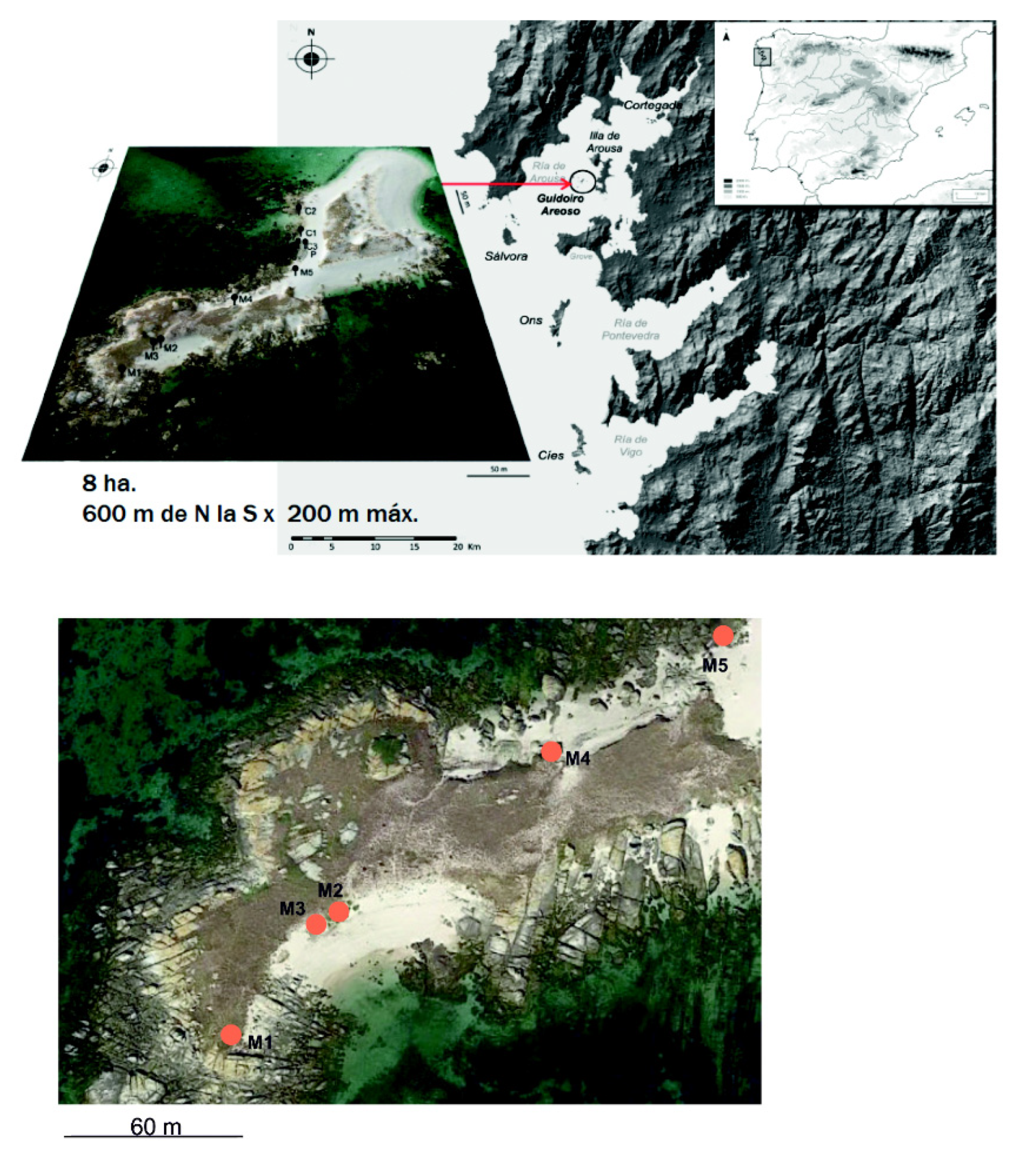
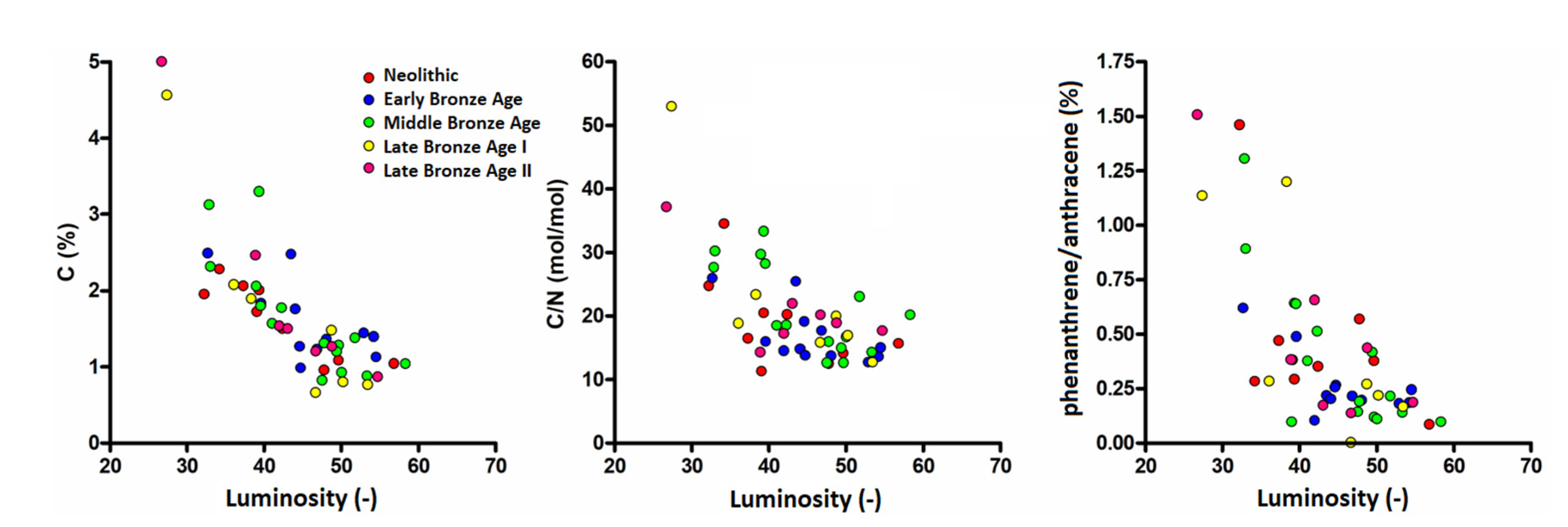

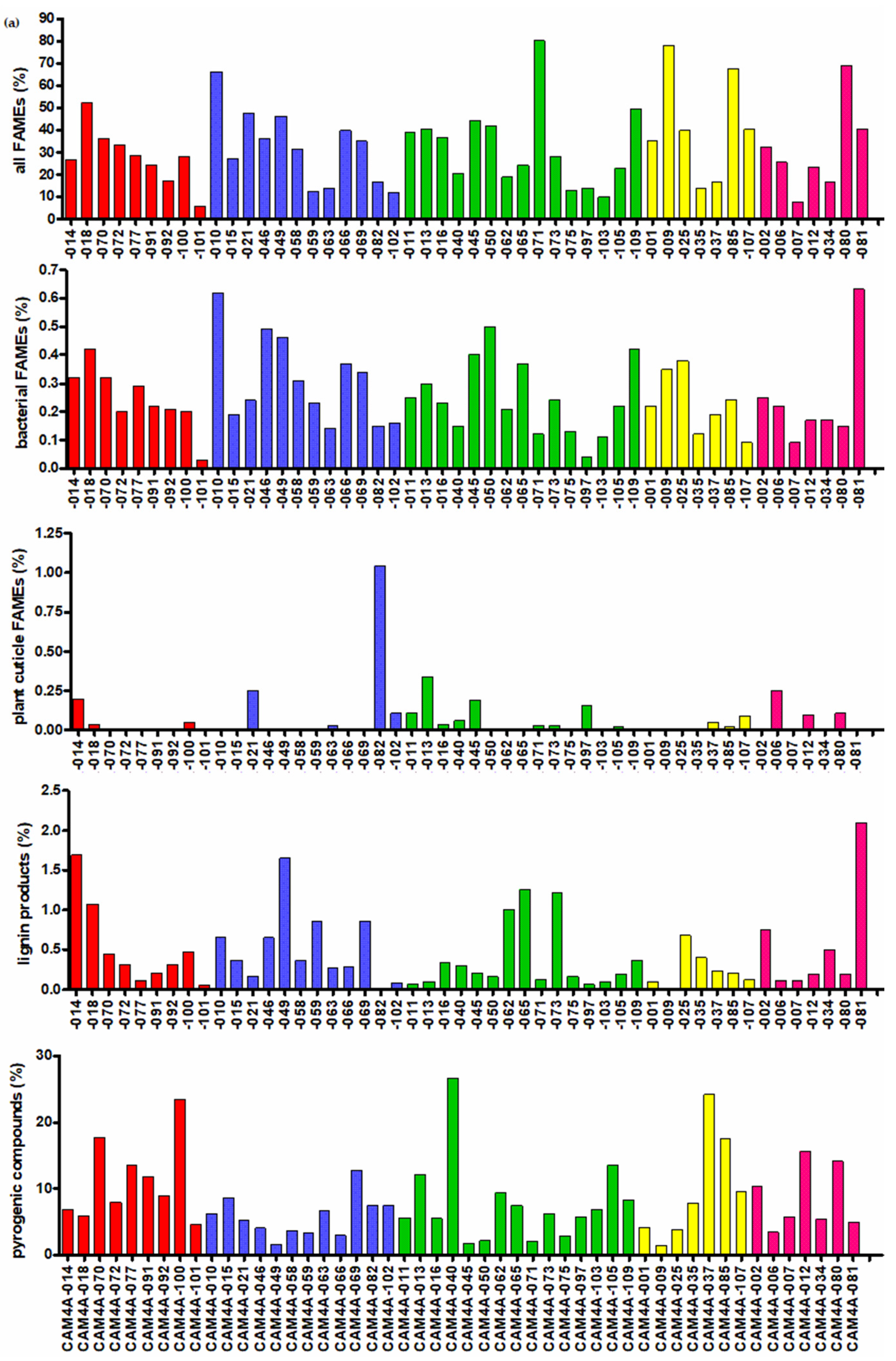
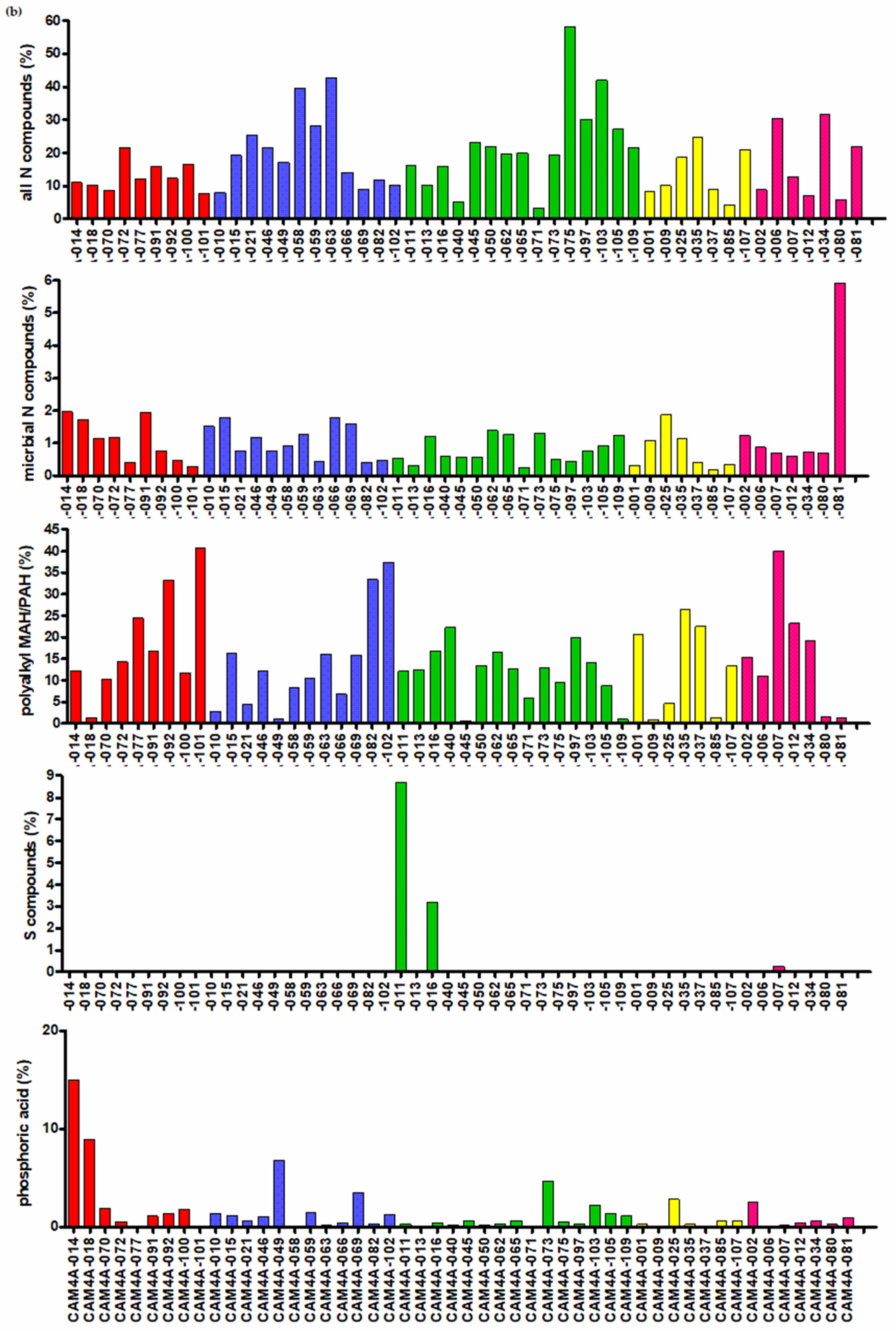
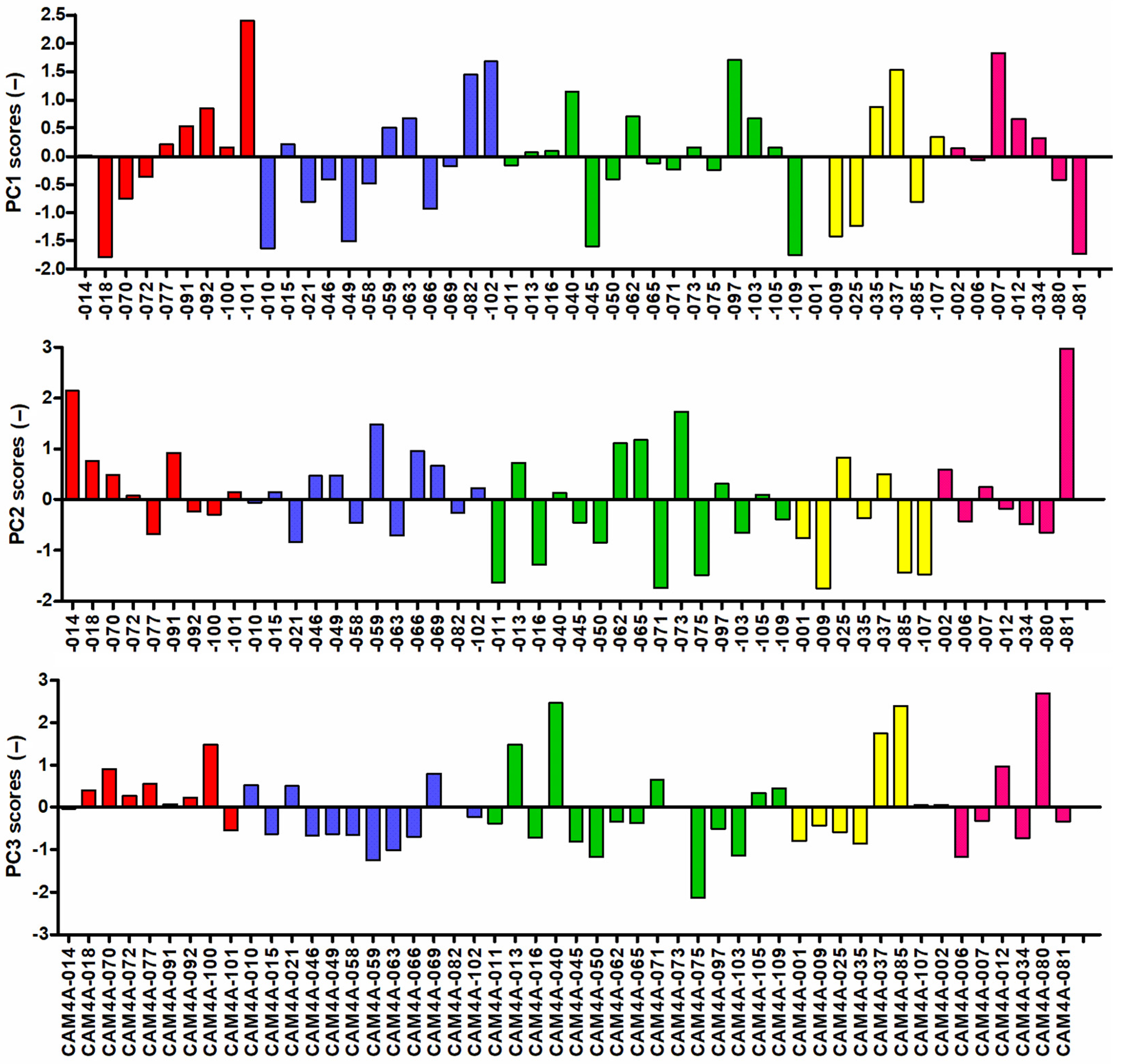
| Sample | Cultural Period | VAR1 | VAR2 | % C | C:N | L* | a* | b* | Chr | Hue |
|---|---|---|---|---|---|---|---|---|---|---|
| CAM4A-001 | Late Bronze Age I | Intermediate | Post waste deposit | 0.76 | 12.7 | 53 | 14 | 26 | 30 | 61 |
| CAM4A-002 | Late Bronze Age II | Low | Post waste deposit | 1.26 | 18.9 | 49 | 10 | 21 | 23 | 65 |
| CAM4A-006 | Late Bronze Age II | Low | Marine influence | 0.86 | 17.6 | 55 | 8 | 19 | 21 | 69 |
| CAM4A-007 | Late Bronze Age II | Low | Marine influence | 1.20 | 20.1 | 47 | 3 | 10 | 10 | 74 |
| CAM4A-009 | Late Bronze Age I | Intermediate | Post waste deposit | 0.65 | 15.8 | 47 | 13 | 26 | 29 | 64 |
| CAM4A-010 | Early Bronze Age | Intermediate | Post waste deposit | 1.36 | 13.6 | 48 | 6 | 14 | 15 | 69 |
| CAM4A-011 | Middle Bronze Age | Intermediate | Post waste deposit | 1.28 | 12.6 | 50 | 9 | 22 | 24 | 67 |
| CAM4A-012 | Late Bronze Age II | Low | Marine influence | 1.53 | 17.2 | 42 | 6 | 15 | 16 | 68 |
| CAM4A-013 | Middle Bronze Age | High | Waste deposit | 3.29 | 33.3 | 39 | 10 | 19 | 22 | 63 |
| CAM4A-014 | Late Neolithic | High | Waste deposit | 1.08 | 14.0 | 50 | 5 | 14 | 14 | 71 |
| CAM4A-015 | Early Bronce Age | High | Waste deposit | 1.12 | 14.9 | 55 | 14 | 26 | 30 | 63 |
| CAM4A-016 | Middle Bronze Age | High | Waste deposit | 0.87 | 14.2 | 53 | 18 | 31 | 36 | 61 |
| CAM4A-018 | Late Neolithic | Intermediate | Post waste deposit | 2.27 | 34.5 | 34 | 2 | 11 | 11 | 77 |
| CAM4A-021 | Early Bronze Age | Low | Post waste deposit | 2.49 | 25.9 | 33 | 2 | 6 | 7 | 69 |
| CAM4A-025 | Late Bronze Age I | Intermediate | Post waste deposit | 2.07 | 18.8 | 36 | 6 | 14 | 15 | 68 |
| CAM4A-034 | Late Bronze Age II | Low | Marine influence | 1.50 | 21.9 | 43 | 3 | 11 | 11 | 72 |
| CAM4A-035 | Late Bronze Age I | Intermediate | Marine influence | 0.79 | 16.9 | 50 | 12 | 24 | 27 | 64 |
| CAM4A-037 | Late Bronze Age I | Intermediate | Post waste deposit | 1.89 | 23.3 | 38 | 8 | 16 | 18 | 65 |
| CAM4A-040 | Middle Bronze Age | High | Waste deposit | 3.12 | 27.6 | 33 | 5 | 11 | 12 | 66 |
| CAM4A-045 | Middle Bronze Age | High | Waste deposit | 0.82 | 12.6 | 48 | 8 | 19 | 21 | 67 |
| CAM4A-046 | Early Bronze Age | High | Waste deposit | 1.44 | 12.7 | 53 | 6 | 16 | 17 | 69 |
| CAM4A-049 | Early Bronze Age | Low | Marine influence | 1.53 | 14.5 | 42 | 7 | 17 | 19 | 69 |
| CAM4A-050 | Middle Bronze Age | Intermediate | Post waste deposit | 1.03 | 20.1 | 58 | 15 | 29 | 32 | 63 |
| CAM4A-058 | Early Bronze Age | High | Waste deposit | 2.47 | 25.4 | 44 | 5 | 14 | 15 | 69 |
| CAM4A-059 | Early Bronze Age | High | Waste deposit | 1.75 | 14.7 | 44 | 5 | 14 | 15 | 72 |
| CAM4A-062 | Middle Bronze Age | High | Waste deposit | 1.19 | 14.9 | 49 | 10 | 21 | 23 | 66 |
| CAM4A-063 | Early Bronze Age | High | Waste deposit | 1.39 | 13.5 | 54 | 9 | 20 | 21 | 65 |
| CAM4A-065 | Middle Bronze Age | High | Waste deposit | 1.77 | 18.5 | 42 | 5 | 14 | 15 | 69 |
| CAM4A-066 | Early Bronze Age | Intermediate | Post waste deposit | 0.98 | 13.7 | 45 | 4 | 14 | 15 | 73 |
| CAM4A-069 | Early Bronze Age | Intermediate | Post waste deposit | 1.83 | 15.9 | 40 | 5 | 13 | 14 | 68 |
| CAM4A-070 | Late Neolithic | High | Waste deposit | 2.05 | 16.4 | 37 | 3 | 9 | 10 | 70 |
| CAM4A-071 | Middle Bronze Age | Low | Marine influence | 2.05 | 29.6 | 39 | 5 | 14 | 14 | 70 |
| CAM4A-072 | Late Neolithic | High | Waste deposit | 2.00 | 20.4 | 39 | 4 | 10 | 11 | 70 |
| CAM4A-073 | Middle Bronze Age | High | Waste deposit | 1.56 | 18.4 | 41 | 4 | 12 | 13 | 70 |
| CAM4A-075 | Middle Bronze Age | Hight | Waste deposit | 0.92 | 16.6 | 50 | 17 | 30 | 34 | 60 |
| CAM4A-077 | Middle Neolithic | Intermediate | Marine influence | 1.49 | 20.2 | 42 | 7 | 17 | 18 | 68 |
| CAM4A-080 | Late Bronze Age II | High | Marine influence | 4.99 | 37.1 | 27 | 2 | 5 | 5 | 68 |
| CAM4A-081 | Late Bronze Age II | High | Marine influence | 2.46 | 14.2 | 39 | 2 | 8 | 9 | 74 |
| CAM4A-082 | Early Bronze Age | High | Waste deposit | 1.26 | 19.1 | 45 | 9 | 20 | 22 | 66 |
| CAM4A-085 | Late Bronze Age I | Low | Marine influence | 4.56 | 52.9 | 27 | 3 | 6 | 7 | 63 |
| CAM4A-091 | Late Neolithic | Intermediate | Post waste deposit | 0.95 | 12.4 | 48 | 9 | 18 | 20 | 64 |
| CAM4A-092 | Late Neolithic | High | Waste deposit | 1.71 | 11.2 | 39 | 3 | 10 | 11 | 71 |
| CAM4A-097 | Middle Bronze Age | High | Waste deposit | 1.37 | 23.0 | 52 | 6 | 17 | 18 | 69 |
| CAM4A-100 | Late Neolithic | Low | Marine influence | 1.95 | 24.6 | 32 | 5 | 11 | 12 | 67 |
| CAM4A-101 | Late Neolithic | Low | Marine influence | 1.04 | 15.6 | 57 | 2 | 9 | 9 | 75 |
| CAM4A-102 | Early Bronze Age | High | Waste deposit | 1.23 | 17.6 | 47 | 8 | 18 | 20 | 66 |
| CAM4A-103 | Middle Bronze Age | High | Waste deposit | 1.31 | 15.9 | 48 | 5 | 15 | 16 | 71 |
| CAM4A-105 | Middle Bronze Age | High | Waste deposit | 2.31 | 30.1 | 33 | 4 | 9 | 9 | 66 |
| CAM4A-107 | Late Bronze Age I | Intermediate | Post waste deposit | 1.47 | 19.9 | 49 | 12 | 24 | 27 | 63 |
| CAM4A-109 | Middle Bronze Age | High | Waste deposit | 1.79 | 28.1 | 40 | 5 | 14 | 15 | 69 |
| Group | Fatty Acids | PyOM | Polyalkyl Aromatic Compounds | Nitrogen Compounds | Polyphenols |
|---|---|---|---|---|---|
| Description | FAMEs | Pyrogenic organic matter products | Polyalkyl MAH/PAH | Products with nitrogen | Lignin (P6, G6, S6) |
| Origen | microbial/dietary | Interior ceramic (temper/binder), exterior (soot) | Tentatively marine | Microbial (marine/terrestrial), molluscs | Plant remains |
| Indicator | Food/abandonment | Firing/cooking | abandonment | abandonment | abandonment |
| PCA | −PC1 | +PC3 | +PC1 | +PC2 | +PC2 |
| Operative chain? | Post- depositional/dietary | Temper and soil OM in raw material | Post-depositional | Post-depositional (proteinaceous food) | Post-depositional (temper) |
Publisher’s Note: MDPI stays neutral with regard to jurisdictional claims in published maps and institutional affiliations. |
© 2021 by the authors. Licensee MDPI, Basel, Switzerland. This article is an open access article distributed under the terms and conditions of the Creative Commons Attribution (CC BY) license (https://creativecommons.org/licenses/by/4.0/).
Share and Cite
Kaal, J.; Castro González, M.G.; Martínez Cortizas, A.; Prieto Martínez, M.P. Use of Thermally Assisted Hydrolysis and Methylation (THM-GC-MS) to Unravel Influence of Pottery Production and Post-Depositional Processes on the Molecular Composition of Organic Matter in Sherds from a Complex Coastal Settlement. Separations 2021, 8, 140. https://doi.org/10.3390/separations8090140
Kaal J, Castro González MG, Martínez Cortizas A, Prieto Martínez MP. Use of Thermally Assisted Hydrolysis and Methylation (THM-GC-MS) to Unravel Influence of Pottery Production and Post-Depositional Processes on the Molecular Composition of Organic Matter in Sherds from a Complex Coastal Settlement. Separations. 2021; 8(9):140. https://doi.org/10.3390/separations8090140
Chicago/Turabian StyleKaal, Joeri, María Guadalupe Castro González, Antonio Martínez Cortizas, and María Pilar Prieto Martínez. 2021. "Use of Thermally Assisted Hydrolysis and Methylation (THM-GC-MS) to Unravel Influence of Pottery Production and Post-Depositional Processes on the Molecular Composition of Organic Matter in Sherds from a Complex Coastal Settlement" Separations 8, no. 9: 140. https://doi.org/10.3390/separations8090140
APA StyleKaal, J., Castro González, M. G., Martínez Cortizas, A., & Prieto Martínez, M. P. (2021). Use of Thermally Assisted Hydrolysis and Methylation (THM-GC-MS) to Unravel Influence of Pottery Production and Post-Depositional Processes on the Molecular Composition of Organic Matter in Sherds from a Complex Coastal Settlement. Separations, 8(9), 140. https://doi.org/10.3390/separations8090140







